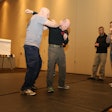The Boise River meanders lazily through Idaho's capital city, lined on both banks by forested green space that attracts wildlife and people alike. Bald eagles and hawks soar overhead. Runners jog along shady, paved pathways. During summer months, thousands of well-behaved Boiseans float the river in inner tubes and inflatable rafts, enjoying sunshine and good times.
Life along the waterway was not always this idyllic, however. Less than a decade ago, overgrown brush provided cover for numerous riverside homeless camps, trash littered the Greenbelt, and alcohol-fueled fights among floaters were a frequent occurrence. The tree-lined park itself was the site of aggravated assaults, drug sales, rapes, and three homicides in four years.
"It was a very ugly time, from '97 to 2000," says Capt. Jim Kerns, a 24-year veteran of the Boise Police Department. "[The violence] was extremely significant to our city fathers, because the Greenbelt was considered our gem. There was outcry from our citizens about the apparent lack of safety...We decided we needed to take proactive action."
What followed was a crime-cleanup campaign that enabled the Boise PD-along with business groups, government agencies, neighborhood associations, and citizen volunteers-to reclaim the river.
Kerns admits that he was doubtful about effecting change after years of parkland neglect, and a 30-year tradition of party-hearty behavior on the seven-mile river float through Boise's city center.
"When I first took it over, I said, 'I don't know how we're going to make this work,'" he notes. "In addition to the littering, indecent exposures, public urination, and fights, we also had problems with bridge jumping [into the river] and alcohol-related near-drownings.
"That was the root of our problem: How do we impact that wide variety of activities?"
In November 2004, Boise PD and Kerns started planning in earnest, bringing together a coalition of citizen and government stakeholders. The group included neighborhood activists, social-service agencies, business associations, and a patchwork of government agencies that tended the river area. They all spent five months hammering out the details of a citywide river-reclamation campaign.
Law enforcement agencies were key players. The Ada County Sheriff's Office has jurisdiction over the raft launch site outside city limits. The Idaho Department of Fish and Game monitors recreational activities on the state waterway. Boise PD takes enforcement action within city limits and along the river as it flows past Boise State University.
Police were hamstrung by several factors. An existing city ordinance prohibited open containers of alcohol on the Boise River. But police rarely enforced it, primarily because ground-bound officers couldn't readily reach offenders on the river. Homeless camps, typically built under bridges, were difficult to access. Just two bicycle officers were assigned to Greenbelt patrol, and only during summer months.
Clearly, the city needed to pay more attention to recreation on and around the river. In response, over the span of several years, Boise PD added four more full-time bike officers as well as eight school resource officers that were reassigned to patrol during summer vacation to work the river area and monitor activities on bridges.
The city also created a 60-member, uniformed civilian force to patrol the Greenbelt in golf carts. The volunteers, overseen by a retired Boise PD officer, use walkie-talkies to alert sworn officers to problems and educate people about park rules.
For the first time, the department also put officers on the river itself.
Boise PD was awarded a $10,000 grant by the Idaho Department of Parks and Waterways to purchase paddle-propelled, inflatable pontoon boats; personal floatation devices; river-rescue helmets; and other equipment that enabled officers to participate in the float and make riverside arrests, if necessary.
"We would usually launch two or three at a time," says Officer Russ Swift, who led the patrol in summer 2005. "We'd float the current for a while, or sometimes we'd sit back where we could watch, with the goal of being seen. We wouldn't just float down the river and be done in two hours. People didn't know where we would be."
To stem littering problems, city and county parks personnel installed portable toilet facilities, trash bins, and recycling containers at riverside rest stops along the 23-mile-long Greenbelt.
In a well-received campaign, police officers occasionally rode with Boise firefighters on the Boise Fire Department's motorized Zodiac boat. Officers educated floaters about responsible behavior, while firefighters shared injury-prevention advice. Additional guidelines-including information about ordinances prohibiting open containers of alcohol on the river, or within 250 feet of it-were publicized on area radio stations, in newspapers, and via brochures distributed at the river launch point.
"We decided to approach it from an education standpoint," says Swift, a seven-year veteran of Boise PD. "[We] put officers on the river to enforce the city's ordinances, but also to buttress the education: We wanted to tell them why the ordinance was there."
A year later, the initial investment in an "education first, regulate when necessary" approach, and marketing efforts are paying big dividends. From June through August 2005, Boise PD officers made 2,000 contacts with floaters, issued a total of 22 citations for open container/illegal consumption violations, and made three arrests. Compare that with summer 2004, when officers wrote 97 citations and made 15 arrests-in just two days.
The campaign is also saving money. In 1994, for example, the city spent $101,000 to enforce the Boise River, including repair costs for damaged recreational facilities and river-rescue calls. In 2005, the city paid less than $54,000.
"We have significantly increased the safety and livability, or 'visit-ability,' of our Greenbelt and river system," Kerns notes. "We have cleaned up the behavior and made it a family-friendly event, like it used to be back when I was a kid in the late '60s and early '70s."
Bryn Bailer is a former newspaper reporter and contributing editor for Police. She is based in Tucson, Ariz.















